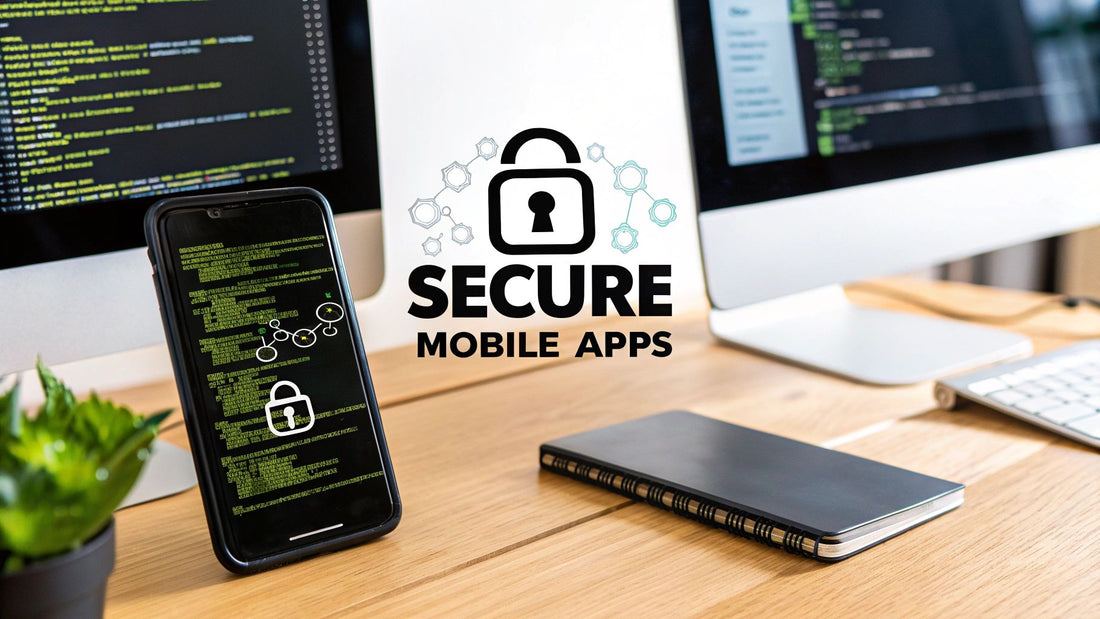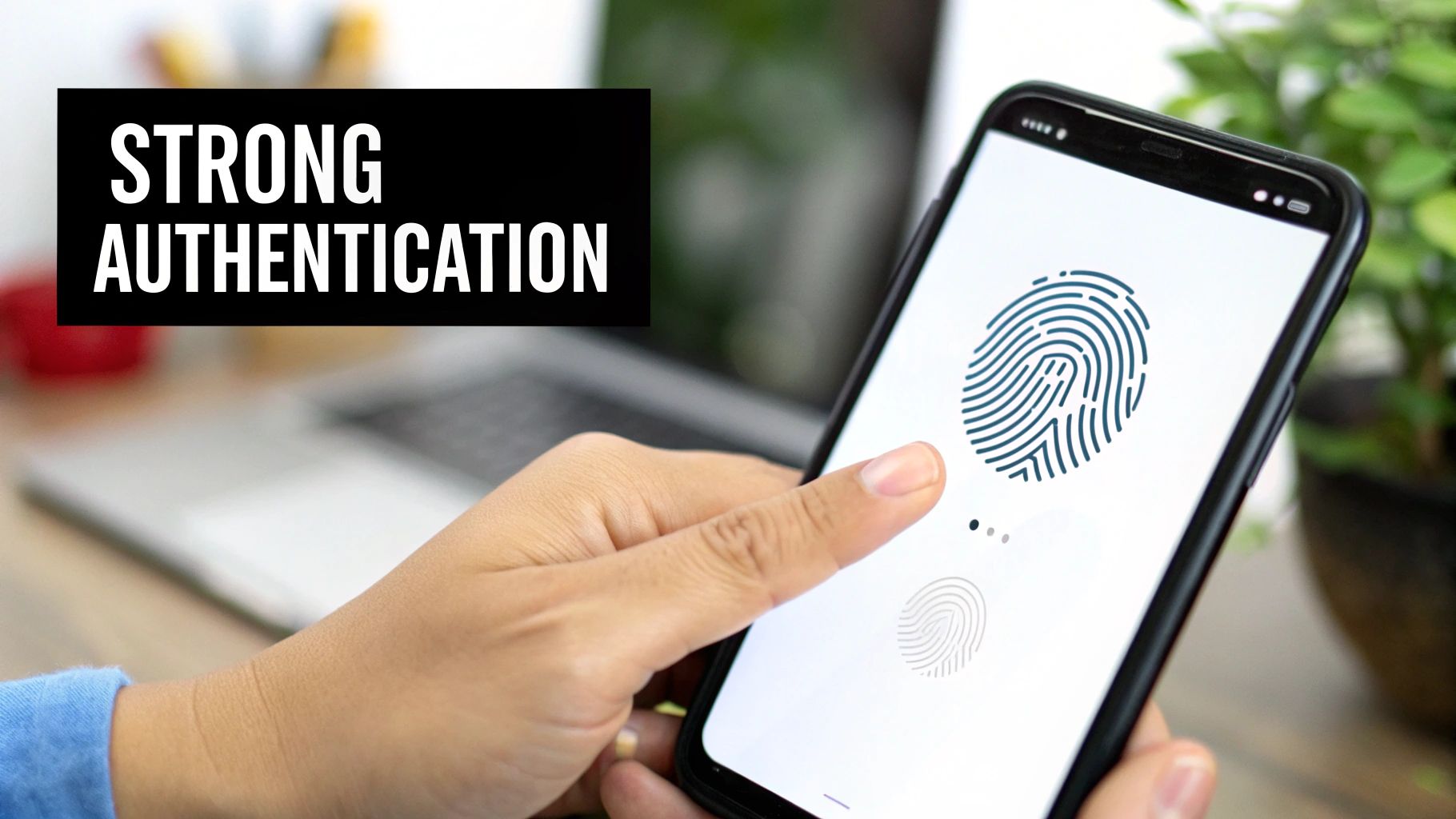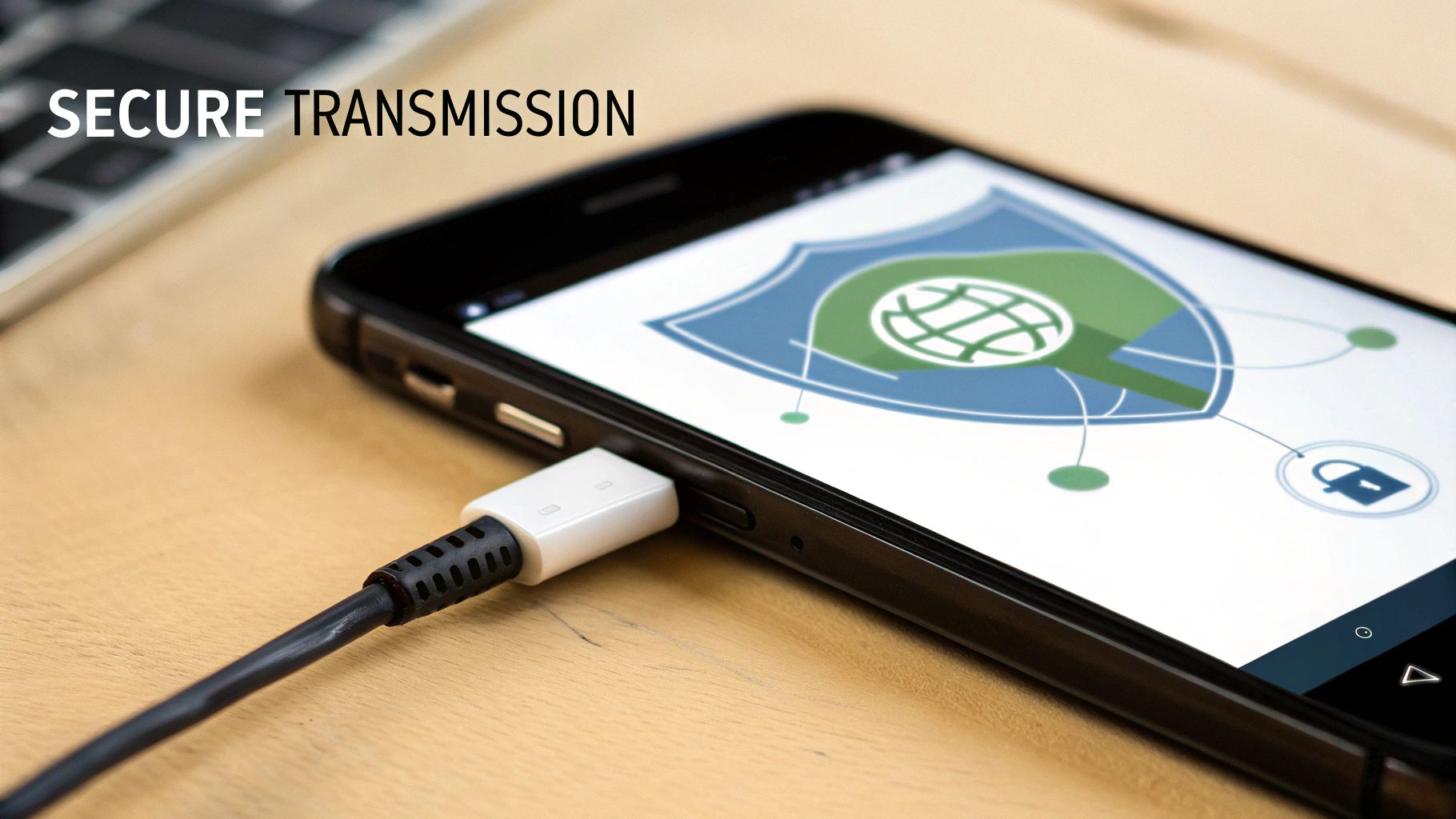
8 Essential Mobile App Security Best Practices for 2025
Share
In a hyper-connected market, a mobile application often serves as the primary gateway to your business. With millions of apps vying for user attention, the risk of security breaches, data leaks, and malicious attacks has escalated dramatically. A single vulnerability can trigger severe consequences, from significant financial loss and brand damage to a complete erosion of customer trust. For this reason, integrating security into every phase of the app lifecycle is not merely a suggestion; it's a foundational pillar for sustainable success.
This guide moves beyond generic advice to provide a comprehensive roundup of the most critical mobile app security best practices. We will dissect eight essential pillars of a robust security posture, covering the entire development process from initial architecture to post-launch maintenance. You will learn how to:
- Implement strong authentication and secure data storage.
- Protect network communications and validate all inputs.
- Harden your app against reverse engineering and tampering.
- Secure your APIs and maintain a rigorous testing schedule.
Each section offers actionable steps, practical examples, and expert insights to help you build applications that are resilient and secure by design. By adopting these mobile app security best practices, you can effectively safeguard your users' sensitive data and protect your business from an ever-growing landscape of sophisticated threats. Let’s dive into the essential strategies for fortifying your mobile application.
1. Implement Strong Authentication and Authorization
Robust authentication is the primary gatekeeper for your mobile app, acting as the first line of defense against unauthorized access. It’s not just about asking for a password; it’s about verifying a user’s identity with high confidence. Authorization, its critical counterpart, then determines what an authenticated user is permitted to do within the app, ensuring they can only access the data and features relevant to their role. This dual approach is a cornerstone of modern mobile app security best practices.

Implementing this involves a multi-layered strategy that combines multiple verification factors, often categorized as something you know (password, PIN), something you have (a physical token, a smartphone), or something you are (fingerprint, facial recognition). For example, banking apps like Chase Mobile often combine a biometric factor like a fingerprint with a PIN for high-risk actions. Similarly, enterprise apps frequently integrate with robust identity providers like Microsoft Azure AD to manage user permissions centrally and securely.
Key Implementation Strategies
To effectively strengthen your app’s access controls, consider these actionable steps:
- Embrace Multi-Factor Authentication (MFA): Go beyond simple username and password combinations. Integrate MFA using biometrics (Apple's Face ID, Android's BiometricPrompt API), one-time passwords (OTP) via SMS or authenticator apps like Google Authenticator, or push notifications.
- Use Secure Token Management: After authentication, issue short-lived access tokens (like JSON Web Tokens or JWTs) instead of storing credentials on the device. These tokens should be stored securely in the device's keychain or Keystore, not in plaintext files or shared preferences.
- Implement Role-Based Access Control (RBAC): For authorization, define clear user roles and permissions on the server side. The client application should never be trusted to enforce its own access rights. An admin user should have different API endpoint access than a standard user.
- Enforce Session Timeouts: Automatically log users out after a period of inactivity. This minimizes the risk of unauthorized access from a lost or unattended device. The timeout duration should be configurable and appropriate for the app's sensitivity level.
By layering these authentication and authorization mechanisms, you create a formidable barrier that significantly reduces the risk of account takeovers and unauthorized data access. For a deeper dive into credential security, you can explore the essential principles of modern password management for 2025 and beyond.
2. Secure Data Storage and Encryption
Protecting user data is non-negotiable, and a comprehensive approach to securing it both at rest (while stored on the device) and in transit (while communicating with a server) is a fundamental pillar of mobile app security best practices. This involves using strong cryptographic algorithms to render data unreadable to unauthorized parties. Without robust encryption, sensitive information like user credentials, personal details, and financial data stored locally or transmitted over networks is highly vulnerable to interception and theft.

Effective data protection goes beyond simply applying an encryption library. It requires a strategic implementation that covers the entire data lifecycle within your app. For instance, messaging apps like Signal and WhatsApp are renowned for their end-to-end encryption, which ensures that only the communicating users can read messages. On the hardware level, Apple’s Secure Enclave and Google’s Titan M security chip provide a protected area for storing sensitive cryptographic keys, making it extremely difficult for attackers to extract them even with physical access to the device.
Key Implementation Strategies
To ensure the data your application handles remains confidential and secure, integrate these critical strategies:
- Utilize Platform-Provided Secure Storage: Leverage the native, hardware-backed secure storage solutions available on each platform. For iOS, use the Keychain for storing small amounts of sensitive data like tokens and keys. For Android, use the Keystore system, which provides cryptographic key management in a secure container.
- Encrypt Data at Rest: Never store sensitive information in plaintext within local files, preferences, or databases. Encrypt all sensitive data, such as PII or authentication tokens, before writing it to the device's storage. Use strong, industry-standard algorithms like AES-256.
- Secure Data in Transit: All communication between the mobile app and its backend servers must be encrypted using Transport Layer Security (TLS). To defend against man-in-the-middle attacks, implement certificate pinning, which ensures the app only trusts a specific, pre-defined server certificate.
- Practice Secure Key Management: The security of your encryption is only as strong as your key management. Never hardcode encryption keys in the source code or store them alongside the encrypted data. Use the platform’s Keystore or Keychain to generate and manage keys securely. Implement a key rotation policy to limit the potential impact of a compromised key.
3. Secure Network Communications
Once a user is authenticated, the next critical security frontier is the data itself as it travels between the mobile app and your backend servers. Securing network communications is about creating a private, encrypted tunnel to protect data in transit from being intercepted, read, or altered by malicious actors. Without this protection, sensitive information like login credentials, personal data, and financial details can be exposed through man-in-the-middle (MITM) attacks, especially on unsecured public Wi-Fi networks. This makes robust network security one of the most vital mobile app security best practices.

The standard approach is to enforce Transport Layer Security (TLS) for all network traffic, ensuring that data is encrypted end-to-end. However, modern security goes further. For instance, high-security applications like banking apps often implement certificate pinning, a technique where the app is hardcoded to only trust specific server certificates, preventing attackers from using fraudulent certificates to intercept traffic. Similarly, Google's Certificate Transparency project helps detect maliciously issued SSL/TLS certificates, adding another layer of validation to the communication channel.
Key Implementation Strategies
To effectively protect data in transit and fortify your app’s network layer, focus on these essential steps:
- Enforce TLS for All Communications: Mandate the use of the latest version of TLS (currently TLS 1.3) for all API calls and data transfers. Never allow unencrypted HTTP connections. Use platform-specific configurations like Android's Network Security Configuration or iOS's App Transport Security (ATS) to enforce this.
- Implement Certificate Pinning: To defend against sophisticated MITM attacks, embed (or "pin") the server's public key or certificate within your app. This ensures the app only connects to your authentic server. Be sure to include backup pins and a plan for updating them to avoid locking users out if a certificate expires or is compromised.
- Validate SSL/TLS Certificates Properly: Ensure your application code correctly validates the entire certificate chain presented by the server. It should check for the hostname, expiration date, and trust chain up to a valid root Certificate Authority (CA). Avoid custom code that accepts self-signed or invalid certificates, even in development environments.
- Use Secure HTTP Headers: Configure your server to send security-enhancing HTTP headers. Headers like HTTP Strict Transport Security (HSTS) force browsers and apps to communicate only over HTTPS, while a strong Content Security Policy (CSP) can prevent various injection attacks.
By implementing these measures, you create a secure channel that is resilient against eavesdropping and data manipulation. This is especially important for apps handling sensitive data and is a core principle in broader security frameworks, which you can explore in these remote work security best practices on accountshare.ai.
4. Robust Input Validation and Sanitization
Failing to properly validate and sanitize user input is like leaving your app’s front door wide open to a variety of attacks. Every piece of data entered by a user, from a search query to a profile update, is a potential vector for malicious activity. Robust input validation is the practice of strictly checking all incoming data to ensure it conforms to expected formats, types, and lengths, while sanitization involves cleaning or neutralizing any potentially harmful characters or code snippets. This process is a foundational element of mobile app security best practices, preventing common yet devastating vulnerabilities like SQL injection and Cross-Site Scripting (XSS).

This principle is highlighted in nearly every major security framework, including the OWASP Top 10 and the CWE/SANS Top 25 Most Dangerous Software Weaknesses. For instance, an e-commerce app must validate that a quantity field contains only numbers, preventing a user from entering malicious scripts. Similarly, when a user searches for a product, the app must sanitize the input string to strip out any SQL commands that could be used to manipulate the database. Effective implementation requires treating all user-supplied data as untrusted until it has been thoroughly vetted on the server side.
Key Implementation Strategies
To build a strong defense against input-based attacks, developers should integrate the following critical practices:
- Enforce Server-Side Validation: While client-side validation provides a good user experience by giving immediate feedback, it can be easily bypassed. The authoritative validation must always happen on the server. The server should never trust data coming from the mobile client.
- Adopt a Whitelisting Approach: Instead of trying to block a list of known bad characters (blacklisting), define exactly what is allowed (whitelisting). For example, a username field might only permit alphanumeric characters and underscores within a specific length. This is far more secure as it rejects everything not explicitly permitted.
- Use Parameterized Queries: To prevent SQL injection, always use parameterized queries (also known as prepared statements) for database interactions. This practice ensures that user input is treated as data, not as executable code, making it impossible for an attacker to alter the query's logic.
- Implement Proper Error Handling: When invalid input is detected, provide generic, non-descriptive error messages to the user. Revealing specific details like "Invalid character in SQL syntax" can give attackers valuable clues about your app's underlying structure and vulnerabilities.
5. Application Obfuscation and Anti-Tampering
Once your app is deployed, it resides on user devices outside of your control, making it vulnerable to reverse engineering and modification. Application obfuscation and anti-tampering are advanced defensive measures designed to make your code unintelligible to attackers and to detect and respond to unauthorized changes. Obfuscation transforms your human-readable code into a complex, functionally identical version that is difficult to analyze, while anti-tampering mechanisms verify the app's integrity at runtime.
This proactive defense is critical for apps handling sensitive data or proprietary algorithms. For instance, high-value gaming apps often implement sophisticated anti-tampering to prevent cheating, while banking and fintech apps use obfuscation to hide logic for fraud detection and protect cryptographic keys. Tools like GuardSquare’s DexGuard (for Android) and Verimatrix App Shield are widely used to automatically apply these protections, creating a significant barrier against intellectual property theft and malicious repackaging.
Key Implementation Strategies
To effectively shield your app from static and dynamic analysis, integrate these powerful techniques:
- Combine Multiple Obfuscation Techniques: Go beyond simple name mangling. Employ a layered approach that includes control flow obfuscation (making the program’s execution path hard to follow), string encryption (hiding hardcoded strings like API keys), and class encryption. This multifaceted strategy significantly increases the complexity and effort required to reverse engineer the code.
- Implement Runtime Integrity Checks: Your app should be able to verify its own integrity after it launches. This involves checking for code modifications, verifying the app’s signature, and detecting if it’s running on a rooted or jailbroken device. If tampering is detected, the app can take defensive actions, such as shutting down, wiping sensitive data, or alerting a server.
- Use White-Box Cryptography: For critical operations where cryptographic keys must be present in the client-side code, standard key storage is insufficient. White-box cryptography techniques embed keys within the application logic in a way that they can be used for operations without ever being extracted, even with full attacker access to the running process.
- Monitor for Anomalies and Update Defenses: Tampering techniques evolve, so your defenses must too. Implement Runtime Application Self-Protection (RASP) to monitor for suspicious behavior in real-time, such as debugger attachment or code hooking. Regularly update your obfuscation and anti-tampering toolchains to stay ahead of the latest reverse-engineering tools and methods.
By making your application a difficult and unpredictable target, you deter all but the most determined attackers, which is a vital component of a comprehensive mobile app security best practices framework. For further information on safeguarding mobile applications, the OWASP Mobile Security Testing Guide provides an exhaustive resource.
6. Secure API Design and Implementation
Your mobile app is often just the tip of the iceberg; the real power and data reside in your backend services, accessed through Application Programming Interfaces (APIs). A secure API acts as a fortified bridge, ensuring that data moving between the mobile client and the server is protected from interception, manipulation, and unauthorized access. Poorly secured APIs are a primary target for attackers, who can exploit them to bypass client-side controls and directly access sensitive data. Therefore, a secure API design is a non-negotiable component of modern mobile app security best practices.
Implementing this requires a comprehensive strategy that treats the API as a first-class citizen in your security architecture. It involves validating every request, enforcing strict access controls, and protecting against common web-based vulnerabilities. For example, Stripe’s API is a gold standard, employing robust authentication with secret keys, detailed rate limiting to prevent abuse, and clear versioning to maintain security across updates. Similarly, GitHub’s API uses OAuth 2.0 to grant granular, user-approved access to resources, ensuring third-party applications can’t overstep their permissions.
Key Implementation Strategies
To build a resilient and secure API layer for your mobile application, focus on these critical steps:
- Use Strong Authentication and Authorization: Never trust the mobile app. Authenticate and authorize every single API request on the server side. Implement a robust protocol like OAuth 2.0 for third-party access or use signed JWTs to manage user sessions securely.
- Implement Comprehensive Input Validation: Protect against injection attacks (like SQLi and XSS) by rigorously validating all incoming data from the client. This includes checking data types, lengths, formats, and ranges. Reject any request that does not strictly conform to the expected schema.
- Enforce Rate Limiting and Throttling: Prevent brute-force attacks, denial-of-service (DoS) attempts, and API abuse by limiting the number of requests a user or IP address can make within a specific timeframe. This is crucial for protecting both performance and security.
- Log and Monitor All API Interactions: Maintain detailed logs of all API requests and responses. Actively monitor these logs for suspicious activity, such as repeated failed login attempts, requests from unusual locations, or data access patterns that deviate from normal user behavior.
By embedding these principles into your development lifecycle, you create a robust defense for your backend services. For a deeper dive into securing the connections between your mobile app and its backend, explore these essential API security best practices. You can also learn more about how effective user permissions management plays a crucial role in this process.
7. Regular Security Testing and Code Reviews
Security is not a one-time setup; it is an ongoing process of vigilance. Regularly testing your application and reviewing its code are fundamental to discovering and fixing vulnerabilities before malicious actors can exploit them. This systematic approach involves integrating security validation throughout the entire development lifecycle, from initial design to post-release maintenance, ensuring your defenses evolve alongside emerging threats. Proactive testing is a critical component of any robust strategy for mobile app security best practices.
This practice moves security from an afterthought to an integral part of the development workflow, often referred to as "shifting left." Instead of waiting until the end of a project to find flaws, developers identify them early, significantly reducing the cost and complexity of remediation. For example, Microsoft's Security Development Lifecycle (SDL) embeds security activities and checkpoints at every phase of software development. Similarly, Google’s rigorous security code review process ensures that potential issues are caught and addressed by peers before the code is even merged.
Key Implementation Strategies
To effectively embed security testing and reviews into your development process, consider these actionable steps:
- Integrate Security Testing into CI/CD Pipelines: Automate security scans to run with every code commit or build. Use Static Application Security Testing (SAST) tools to analyze source code for flaws and Dynamic Application Security Testing (DAST) tools to test the running application for vulnerabilities like insecure data storage or weak server-side controls.
- Establish Clear Security Code Review Guidelines: Create a standardized checklist for manual code reviews that focuses on common security pitfalls, such as those outlined in the OWASP Mobile Top 10. Ensure that every pull request is reviewed by at least one other developer with a security-conscious mindset.
- Use Multiple Testing Approaches: Combine automated scans with manual penetration testing. While automation is efficient for catching common issues, manual testing by security experts is invaluable for uncovering complex business logic flaws and nuanced vulnerabilities that automated tools might miss.
- Promote Continuous Security Education: Regularly train your development teams on secure coding practices and emerging threats. A knowledgeable team is your first line of defense, capable of writing more secure code from the start and identifying potential issues during peer reviews.
By making security testing and code reviews a consistent, non-negotiable part of your development culture, you create a powerful feedback loop that continuously strengthens your app's security posture. For comprehensive guidance on mobile testing methodologies, refer to the OWASP Mobile Security Testing Guide.
8. Privacy Protection and Compliance
In today's data-driven world, protecting user privacy is not just an ethical obligation but a legal mandate. Privacy protection involves safeguarding user data from misuse, while compliance means adhering to global regulations like GDPR and CCPA. This practice ensures your app respects user rights, builds trust, and avoids severe financial and reputational penalties. It's a critical component of mobile app security best practices that shifts the focus from purely technical defense to a user-centric, rights-based approach.
Implementing this involves building privacy into the core of your app from the very beginning, a concept known as "Privacy by Design." It requires transparent communication, granular user control, and a commitment to data minimization. For example, Apple's App Tracking Transparency (ATT) framework forces apps to explicitly ask for permission before tracking users across other companies' apps and websites. Similarly, Google's Privacy Sandbox initiative aims to create web and mobile technologies that protect people's privacy online while giving companies tools to build thriving digital businesses.
Key Implementation Strategies
To effectively embed privacy and compliance into your mobile app, consider these actionable steps:
- Implement Privacy by Design: Integrate privacy considerations into every stage of the development lifecycle, not as an afterthought. This means collecting only the data you absolutely need (data minimization) and being transparent about why you need it.
- Provide Clear and Accessible Privacy Policies: Your privacy policy should be written in plain, easy-to-understand language. It must clearly state what data you collect, how you use it, who you share it with, and how users can exercise their rights, such as data access or deletion.
- Enable Granular User Consent Controls: Don't bundle consent into a single "I agree" checkbox. Provide users with specific, granular options to opt-in or opt-out of different types of data collection and processing, such as location services, push notifications, or personalized ads.
- Conduct Regular Privacy Impact Assessments (PIAs): Systematically evaluate and document the privacy risks associated with any new feature or data processing activity. This helps you identify potential issues early and implement measures to mitigate them before they impact users.
By prioritizing privacy and adhering to compliance standards, you not only protect your users but also build a foundation of trust that can become a significant competitive advantage. For more information on the principles that guide these practices, you can explore the work of organizations like the International Association of Privacy Professionals (IAPP).
Mobile App Security Best Practices Comparison
| Security Measure | Implementation Complexity 🔄 | Resource Requirements ⚡ | Expected Outcomes 📊 | Ideal Use Cases 💡 | Key Advantages ⭐ |
|---|---|---|---|---|---|
| Implement Strong Authentication and Authorization | High 🔄🔄 | Medium to High ⚡ | Strong access control, reduced unauthorized access 📊📊 | Apps requiring high security: banking, enterprise | High security, regulatory compliance, audit trails ⭐⭐ |
| Secure Data Storage and Encryption | Medium to High 🔄 | High ⚡ | Data confidentiality and integrity 📊📊 | Apps handling sensitive/personal data | Protects data breaches, regulatory compliance ⭐⭐ |
| Secure Network Communications | Medium 🔄 | Medium ⚡ | Secure data transmission, prevents MITM attacks 📊 | All apps with network data exchange | Data integrity in transit, user trust ⭐⭐ |
| Robust Input Validation and Sanitization | Medium 🔄 | Medium ⚡ | Prevention of injection attacks, app stability 📊 | Apps accepting user inputs, forms, APIs | Reduces vulnerabilities, improves data quality ⭐ |
| Application Obfuscation and Anti-Tampering | High 🔄🔄 | Medium ⚡ | Protection from reverse engineering and tampering 📊 | Mobile applications with IP or sensitive logic | Protects IP, deters reverse engineering ⭐ |
| Secure API Design and Implementation | High 🔄🔄 | Medium to High ⚡ | Secure backend access, prevents API abuse 📊 | Apps relying heavily on APIs and external integrations | Consistent security, scalable, monitored endpoints ⭐ |
| Regular Security Testing and Code Reviews | High 🔄🔄 | High ⚡ | Early vulnerability detection, improved code quality 📊 | Continuous deployment environments, security-critical apps | Reduces risks, improves compliance ⭐⭐ |
| Privacy Protection and Compliance | High 🔄🔄 | Medium to High ⚡ | Regulatory compliance, user data protection 📊 | Apps processing personal data needing compliance | Builds trust, reduces legal risks ⭐ |
Building a Culture of Security
Navigating the complex landscape of mobile app development requires more than just innovative features and a sleek user interface. As we've detailed throughout this guide, true success is built on a foundation of trust, and trust is earned through a relentless commitment to security. The journey from concept to deployment is riddled with potential vulnerabilities, but by systematically applying the mobile app security best practices we've discussed, you can transform your application from a potential target into a digital fortress.
We explored the critical importance of a multi-layered defense, starting with the very first line of code. From implementing strong, multi-factor authentication and granular authorization to ensuring all data, both at rest and in transit, is protected with robust encryption, each practice serves as a vital pillar supporting your overall security posture. Securing network communications with protocols like TLS and employing certificate pinning isn't just a recommendation; it's an essential safeguard against man-in-the-middle attacks that plague insecure applications.
However, a strong perimeter is only part of the equation. The integrity of your application depends just as much on internal vigilance. This means embracing robust input validation to neutralize threats like SQL injection and cross-site scripting, and leveraging application obfuscation and anti-tampering measures to make your code a difficult target for reverse engineering. By treating your APIs as first-class citizens with stringent security protocols, you protect the very lifelines of your application's data flow.
From Checklist to Culture: The Security-First Mindset
Viewing these practices as a mere checklist to be completed before launch is a critical mistake. The threat landscape is not static; it is a dynamic, ever-evolving ecosystem of new exploits and attack vectors. This reality demands a fundamental shift in perspective from a one-time security audit to an ingrained, continuous culture of security.
Key Takeaway: Security is not a feature you add; it's a process you embed into every stage of the application lifecycle, from the initial design mockups to post-launch maintenance and updates.
This cultural shift means empowering every member of your team, from developers and QA engineers to product managers, to think with a security-first mindset. It involves making regular security testing, including static analysis (SAST), dynamic analysis (DAST), and penetration testing, a non-negotiable part of your development sprints. It also means fostering an environment where code reviews are not just for catching bugs but are also rigorous security inspections.
Actionable Next Steps for a More Secure Future
As you move forward, the goal is to operationalize these principles. Don't let this guide become just another bookmarked article. Instead, use it to catalyze immediate action and long-term strategic planning.
- Conduct a Gap Analysis: Review your current development lifecycle against the best practices outlined here. Where are the gaps? Are you validating all inputs? Is your data encryption up to current standards?
- Prioritize and Implement: You may not be able to fix everything at once. Identify the most critical vulnerabilities in your application and create a prioritized roadmap for remediation. Focus on high-impact areas like authentication and data storage first.
- Automate Your Defenses: Integrate automated security scanning tools directly into your CI/CD pipeline. This ensures that security checks are performed automatically with every code commit, catching vulnerabilities early when they are cheapest and easiest to fix.
- Educate and Train: Invest in ongoing security training for your development team. The more they understand about common attack vectors and secure coding techniques, the more resilient your applications will become.
Ultimately, mastering these mobile app security best practices is about more than just mitigating risk. It is about building a product that users can trust with their most sensitive information. In a competitive market, a reputation for robust security is a powerful differentiator that fosters user loyalty and enhances brand value. By weaving security into the very fabric of your development process, you are not just protecting data; you are building a legacy of reliability and trust that will pay dividends for years to come.
Protecting shared accounts requires a security-first approach from the ground up. AccountShare is designed with these principles at its core, providing secure infrastructure to manage and share your digital subscriptions without compromising your credentials or privacy. Experience the peace of mind that comes with a platform built on a foundation of robust security at AccountShare.
